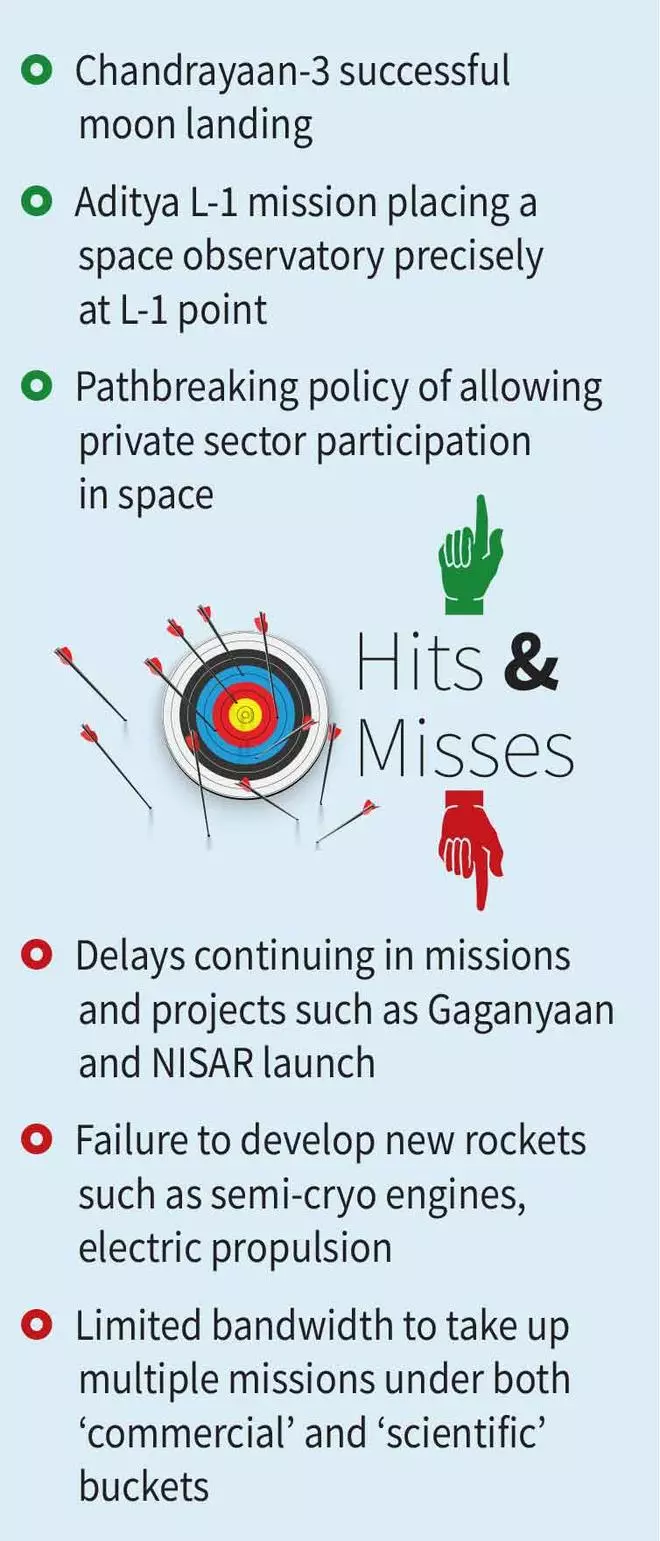The period 2014-24 was an epochal decade for the Indian space sector, when the country climbed ‘up above the world so high’, with a bouquet of mission successes and some path-breaking policy measures. In those 10 years, India built on the foundation laid by the hard work of the previous decades.
One might cleave India’s space odyssey into three phases — seeding, flowering and fruiting.
Think of the seeding phase as the period from the sounding rockets of the 1970s to the development of the PSLV rocket. Until the 1990s, India’s only badge of honour was the PSLV rocket, whose enduring success till date has earned it the sobriquet, ‘workhorse’. For a country that had to bootstrap itself to chart a path into the heavens, the home-grown rocket (which can carry payloads up to 3.25 tonne to low earth orbits or 1.75 tonne to geostationary transfer orbit, 36,000 km above the earth) was a matter of pride, but there was little else to be proud of.

However, scientists were quietly slaving in their labs and their efforts ushered in the flowering phase. In 2001, India launched its first ‘heavy rocket’, the GSLV, albeit with a Russian upper-stage cryogenic engine. The first didn’t leave the launch pad. In the second attempt, the rocket put a (test) satellite in the wrong place. But from then on, the Indian space sector has been steadily climbing the ladder of success. The first moon mission, Chandrayaan-1 (2008) was a cheer, as it did its job and more — of reaching the moon’s orbit and then finding proof of existence of water on it. Then followed the Mangalyaan (2013), when India earned global encomiums by slinging the spacecraft to the Martian orbit in the first attempt, a feat no country had achieved.
When the NDA government took over in 2014, the Indian space sector was thus fortified by the two successes and was licking its paws for further kills. The fruiting phase began.
Moon mission
The crowning moment of India’s space journey was undoubtedly 18:03 hours on August 23, 2023, when the lander of Chandrayaan-3 gently descended on the moon’s surface, making the country only the fourth in the world to do so, after the US, Russia and China. (Japan has since joined the club). The Chandrayaan-3 success (built on the learnings of the failed Chandrayaan-2) was followed by the Aditya L-1 mission’s laudable feat of placing a spacecraft (a space telescope) in the L-1 point between the sun and the earth, 1.5 million km from the earth, from where it would constantly observe the sun. Again, India was only the fourth in the world to do this, after the US, Europe and China.
Alongside, India also developed its own regional navigation satellite system (NaVIC), a regional version of a ‘global positioning system’ (GPS). Only the US, Europe, Russia and China have their own global positioning systems, while Japan and India have regional positioning systems. Further, ISRO developed other rockets — a heavier LVM-3 and a small satellite launch vehicle (SSLV) for smaller payloads, for which there is a big market.
In the meantime, in March 2019, India demonstrated its anti-satellite capability, chasing and hitting a flying (defunct Indian) satellite in the low-earth orbit. Once again, India was only the fourth country to do this, after the US, Russia and China. (India has a bunch of inter-continental ballistic missiles that fly to space and come back, which were developed on the back of the country’s space programme).
Future plans
ISRO has exciting plans — the closer ones are sending two or three Indians to space (Gaganyaan) and bringing them back and missions to explore Venus (Sukrayaan) and an asteroid but on a longer timescale, there are plans to send robotic and manned missions to the moon and build an Indian space station (Bharat Antariksh Station). The developed world, which once balked at giving India technology, is now eager to collaborate. A NASA-ISRO Synthetic Aperture Radar (NISAR), which will provide “an unprecedented view” or the earth below; the French CNES and ISRO have shaken hands to build a Thermal InfraRed Imaging Satellite for High-resolution Natural resource Assessment (TRISHNA), for use in climate monitoring and operational applications.
Private participation
However, even all these successes would be enough to earn 2014-24 the ‘epochal decade’ tag. The epoch-making part of the story is India opening its space sector to private participation. After announcing its intention in June 2020 and setting up the space regulatory, Indian National Space Promotion and Authorisation Centre (IN-SPACe) in October 2021, the Union government unveiled the India Space Policy-2023, in April. The policy set the broad framework for non-government entities’ participation in areas like space vehicles, satellites, dissemination of data and setting up ground stations. The rules for activating the policy were brought out in May 2024. Earlier, the role of the private sector was limited to making components for ISRO.
Now the private sector is rubbing its hands in glee. There are over 400 Indian space companies — about half of them are start-ups (including two rocket manufacturers), which have attracted $330 million in investments in the last three years. ISRO is building a new launch station at Kulasekarapatnam, Tamil Nadu, for small rocket launches. IN-SPACe has received about 500 applications for authorisation and has signed over 50 technology transfer agreements. According to Invest India, the official investment promotion body, India’s space economy was worth $9.6 billion in 2020; the country aspires this number to increase to $44 billion by 2033.

This is the 20th article in the ‘10 years of NDA’ series







